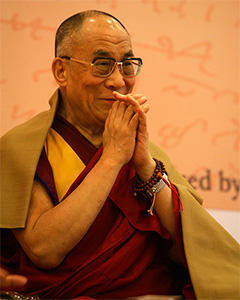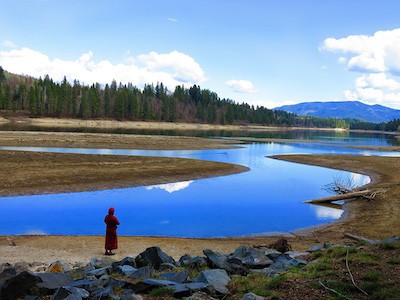A message from His Holiness the Dalai Lama

From Blossoms of the Dharma: Living as a Buddhist Nun, published in 1999. This book, no longer in print, gathered together some of the presentations given at the 1996 Life as a Buddhist Nun conference in Bodhgaya, India.

In working to overcome suffering, we should help others as much as we can. (Photo by abhikrama)
Shakyamuni Buddha attained enlightenment in Bodhgaya over two and a half thousand years ago, yet his teaching remains refreshing and relevant today. No matter who we are or where we live, we all want happiness and dislike suffering. The Buddha recommended that in working to overcome suffering, we should help others as much as we can. He further advised that if we cannot actually be of help, we should at least be careful not to harm anyone.
Part of Buddhist practice involves training our minds through meditation. But if our training in calming our minds, developing qualities like love, compassion, generosity and patience, is to be effective, we must put them into practice in day to day life. In an increasingly interdependent world our own welfare and happiness depend on many other people. As human beings others have a right to peace and happiness equal to our own. We therefore have a responsibility to help those in need.
This conference is mainly focused on the concerns of Buddhist nuns. In the past, in many Buddhist countries, nuns did not have the same educational opportunities as monks, nor access to the same facilities. Due to prevailing social attitudes nuns were often treated or regarded in ways that are no longer acceptable today. I am happy to see that these things are beginning to change. Recently, the first Winter Debate Session for nuns was held in Dharamsala, in which nuns from several nunneries participated successfully. Here was clear evidence of the improved educational standards that nuns now enjoy.
Throughout history there have been individual nuns who rose to eminence, beginning of course with Mahaprajapati. Whatever other qualities they may have had, these women revealed remarkable determination and courage. They were single-minded in the pursuit of their chosen goal, without regard for encouragement or disappointment. I urge you, both as individuals and communities, to adopt a similar approach. I believe that inner peace plays an important role in the development of determination and courage. In that state of mind you can face difficulties with calm and reason, while keeping your inner happiness. In my experience, the Buddha’s teachings of love, kindness and tolerance, the conduct of nonviolence, and especially the view that all things are relative and interdependent are a source of that inner peace.
I have remarked before that whenever Buddhism has taken root in a new land there has always been a certain variation in the style in which it is observed. The Buddha himself taught differently according to the place, the occasion, and the situation of those who were listening to him. To some extent, as Buddhist nuns, you are now participating in the evolution of a Buddhism for a new time, a time when the universal principle of the equality of all human beings takes precedence. It is heartening to observe, as your conference clearly demonstrates, that Buddhist women are casting off traditional and outmoded restraints.
All of you have a great responsibility to take the essence of Buddhism and put it into practice in your own lives. Having taken ordination we must constantly remember that the primary reason for holding vows as a nun or a monk is to be able to dedicate ourselves to the practice of the Dharma. Even if only a few individuals try to create mental peace and happiness within themselves and act responsibly and kind-heartedly towards others, they will have a positive influence in their community. As well as being equally capable, women have an equal responsibility to do this.
I offer my greetings to all participants, as well as my sincere prayers that your conference may be successful in contributing to a more peaceful and happier world.
His Holiness the Dalai Lama
His Holiness the 14th Dalai Lama, Tenzin Gyatso, is the spiritual leader of Tibet. He was born on July 6, 1935, to a farming family, in a small hamlet located in Taktser, Amdo, northeastern Tibet. At the very young age of two, he was recognized as the reincarnation of the previous 13th Dalai Lama, Thubten Gyatso. The Dalai Lamas are believed to be manifestations of Avalokiteshvara or Chenrezig, the Bodhisattva of Compassion and the patron saint of Tibet. Bodhisattvas are believed to be enlightened beings who have postponed their own nirvana and chosen to take rebirth in order to serve humanity. His Holiness the Dalai Lama is a man of peace. In 1989 he was awarded the Nobel Peace Prize for his non-violent struggle for the liberation of Tibet. He has consistently advocated policies of non-violence, even in the face of extreme aggression. He also became the first Nobel Laureate to be recognized for his concern for global environmental problems. His Holiness has traveled to more than 67 countries spanning 6 continents. He has received over 150 awards, honorary doctorates, prizes, etc., in recognition of his message of peace, non-violence, inter-religious understanding, universal responsibility and compassion. He has also authored or co-authored more than 110 books. His Holiness has held dialogues with heads of different religions and participated in many events promoting inter-religious harmony and understanding. Since the mid-1980’s, His Holiness has begun a dialogue with modern scientists, mainly in the fields of psychology, neurobiology, quantum physics and cosmology. This has led to a historic collaboration between Buddhist monks and world-renowned scientists in trying to help individuals achieve peace of mind. (Source: dalailama.com. Photo by Jamyang Dorjee)

